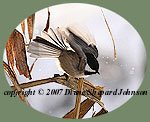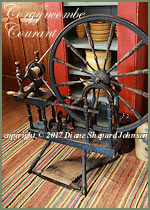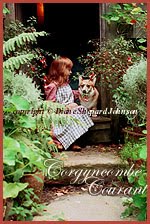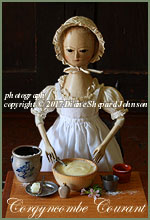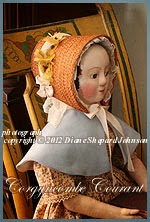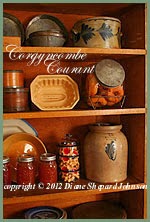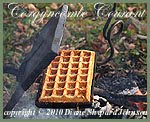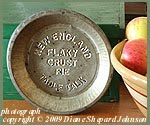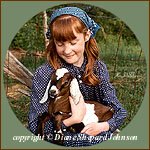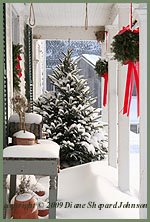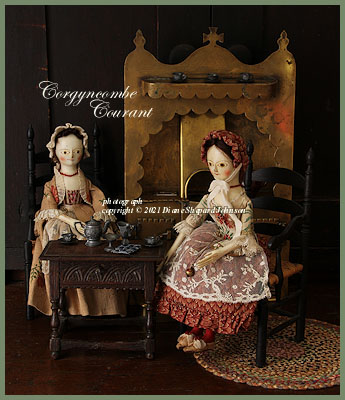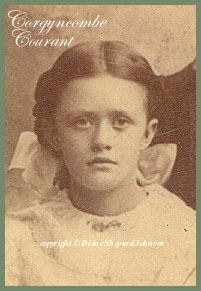The Old Gerrish Homestead!
In "Drawn from New England" Bethany Tudor wrote about how her mother, Tasha Tudor, found a delightful old house and farm in New Hampshire. Even though the house was in disrepair Tasha could see beyond it and her artist's eye could see how wonderful it could be! Tasha bought the old house and farm from an old man named Ed Gerrish in 1945. Ed Gerrish's great grandfather Moses Gerrish built the house about 1789. I was thrilled to discover that the Gerrish family that built and owned the New Hampshire house and farm was related to me!
The old photograph shows the Gerrish Homestead (built about 1789 by Moses Gerrish) in about 1869. The house was later owned by Tasha Tudor. Ed Gerrish was born in 1867. Perhaps he could be the little child in the photo standing by his mother. Photograph courtesy of the Webster Historical Society.
Moses Gerrish's father Col. Henry Gerrish was 2nd cousin to my 6th great grandfather John Hale. Both Henry and John served in the Revolutionary War. Col. Henry Gerrish and John Hale were first cousin and second cousin, respectively, to Nathan Hale the great American patriot.
We found that Moses Gerrish's grandmother was Joanna (Hale) Gerrish. 'Tis no surprise that her name would have been Joanna! In my branch it is a well known Hale family name. The first Hale of the line in New England was Robert Hale and his wife was Joanna. The name Joanna appeared in every generation of Hales down the line in my family (except for one generation which only had sons). Each generation of Hales had a sister Joanna. Nathan Hale, too, had a sister named Joanna.
Tasha Tudor encouraged my daughter and I in our genealogical pursuits and she wrote to us:
James Gerrish served for the Union during the Civil War as part of the New Hampshire Volunteers. Tasha Tudor's dolls Captain Shakespeare and Lieut. Thaddeus Crane both also served in the New Hampshire Volunteers. The wedding of Lieut. Thaddeus Crane and lovely Melissa was held at the old Gerrish house and was featured in "Life" Magazine. Melissa was Tasha Tudor's model for the doll in "A is for Annabelle".
James Gerrish was engaged to Sarah Chandler just before he left for service in the Civil War. They were then married in 1864.
James Gerrish's daughter wrote about how although his responsibilities to care for his family as a farmer meant perhaps he could not pursue another career, he was artistically inclined and he appreciated and found beauty in his life. He raised dairy cows and sheep. He built stone walls. Whilst he was doing work about the farm James made up poems for his daughter. He planted a row a mile and a quarter long of maple trees by the road for tapping and for the pleasure to the senses. He thought this would be a long lasting remembrance of him after he was gone. I remember even as a child appreciating rows of big old maple trees along both sides of the road and also old stone walls, how special!
James Gerrish's brother Henry H. Gerrish's wrote diaries in which he described work and happenings about the farm. In reading them, one can see that they collected sap and did maple sugaring, attended sugaring parties, harvested their own ice and packed it in sawdust, did haying, grew apples, potatoes and other crops, as well as many of the old fashioned tasks that my families also did.
It is interesting to see the perspective from the previous generations' experiences in the same house that Tasha Tudor lived in and experienced some of the same things, too.
James L. Gerrish's daughter Mabel (Ed's sister) wrote down her recollections and stories of the farm and her family.
One can follow through Tasha Tudor's Around the Year and other books and illustrations and see similarities. Tasha Tudor drew many things done on the farm in previous days. "Becky's Birthday", "Becky's Christmas", "Adventures of a Beagle", and "Biggity Bantam" all have Tasha's illustrations of the New Hampshire farm.
Mabel wrote of coming home from school to her mother's "cozy kitchen" through the pantry, which was filled with wonderful things to eat such as pie, doughnuts, cake or cookies. Her description makes me think of Tasha Tudor's detailed illustrations of the pantry and butt'ry with the many things stored there.
Mabel also mentioned that raspberries and blueberries were picked on the farm and made into pies. In Around the Year folks are shown picking berries and having a picnic in July with a pie in the border.
Mabel wrote that her aunt visited her mother's kitchen especially during the time that the peaches were ripe. Around the Year shows a busy kitchen with the ladies putting up peaches.
One year at Thanksgiving when the Gerrishes had many relatives there for dinner in the old kitchen, there was a big snowstorm and some folks had to stay overnight. Mabel spoke highly of the pumpkin pies that were made in the brick oven. During part of the party the children dressed up in old fashioned clothes.
Mabel enjoyed coasting and skating in the winter. Each year a different family in the school district would have a large Christmas tree and everyone would come to the party with gifts, there would music and treats. In Around the Year Tasha Tudor, of course, featured coasting, skating, and a family gathered around the Christmas tree.
Mabel fondly remembered the attic and mentioned some of the old things found there: spinning wheels, cheese presses, old foot stoves, and the big wooden loom. Also in the attic were items related to fashions of the past: hoop skirts and "Godey's Lady's Book" fashion magazines. Perhaps some were of the same time and style as Tasha Tudor's illustrations in the miniature fashion magazines and catalogs that she made for the dolls and critters. The old things in the attic sound like things that Tasha and I would both get excited about!
Tasha Tudor delighted, as we do, in refined, simple elegance, in a country way, and the combining of the every day old fashioned tasks as our ancestors did, with artistic skill that could be seen by the beauty in their accomplished results... such as baskets, clothing, gardens, pottery, textiles, furniture, food preparation, architecture, and even their tools.
Mabel learned to read from her mother and her older college aged brother Ed. When one of Ed's professors came to visit the Gerrishes, he saw that Mabel, a little girl at the time, was reading books that he considered advanced for her age, he sent her the book "Mother Goose". Mabel cherished this "Mother Goose" for many years to come! Later, Tasha Tudor illustrated her version of "Mother Goose" (1944) and used the money she made from it to buy the old Gerrish home.
Henry H. Gerrish's diaries and Mabel (Gerrish) Page's stories can be found at the Webster Historical Society.
Photograph of the Gerrish homestead about 1869 courtesy of the Webster Historical Society.
Some of the photographs and some of the writings on this post are from previous Corgyncombe Courant posts that can be found here on the Corgyncombe Courant and from our web site and our previous postings elsewhere on the internet.
Please do not "Pin" our photographs.
Please do not post our photographs on facebook.
Our email:
atthecottagegate@yahoo.com
If you receive an email you think is from me from this email, please make sure it is atthecottagegate@yahoo.com, and not just something that sounds similar.
Photographs, images, and text copyright © 2000-2024 Diane Shepard Johnson and Sarah E. Johnson.
All rights reserved. Photographs, images, and/or text may not be reproduced in any form without permission in writing from Diane Shepard Johnson and Sarah E. Johnson.
http://corgyncombecourant.blogspot.com/2024/03/tasha-tudors-historic-new-hampshire.html
copyright © 2024 Diane Shepard Johnson and Sarah E. Johnson
~~~~~~~~~~~~~~~~~~

